Game Design: Idea-Generation Techniques, Successful Ideas, and Prototyping
VerifiedAdded on 2022/12/23
|11
|3523
|1
AI Summary
This report focuses on game design and the various aspects of developing a game, including idea-generation techniques, factors contributing to successful ideas, game design proposal, functional prototyping, and gameplay mechanisms.
Contribute Materials
Your contribution can guide someone’s learning journey. Share your
documents today.
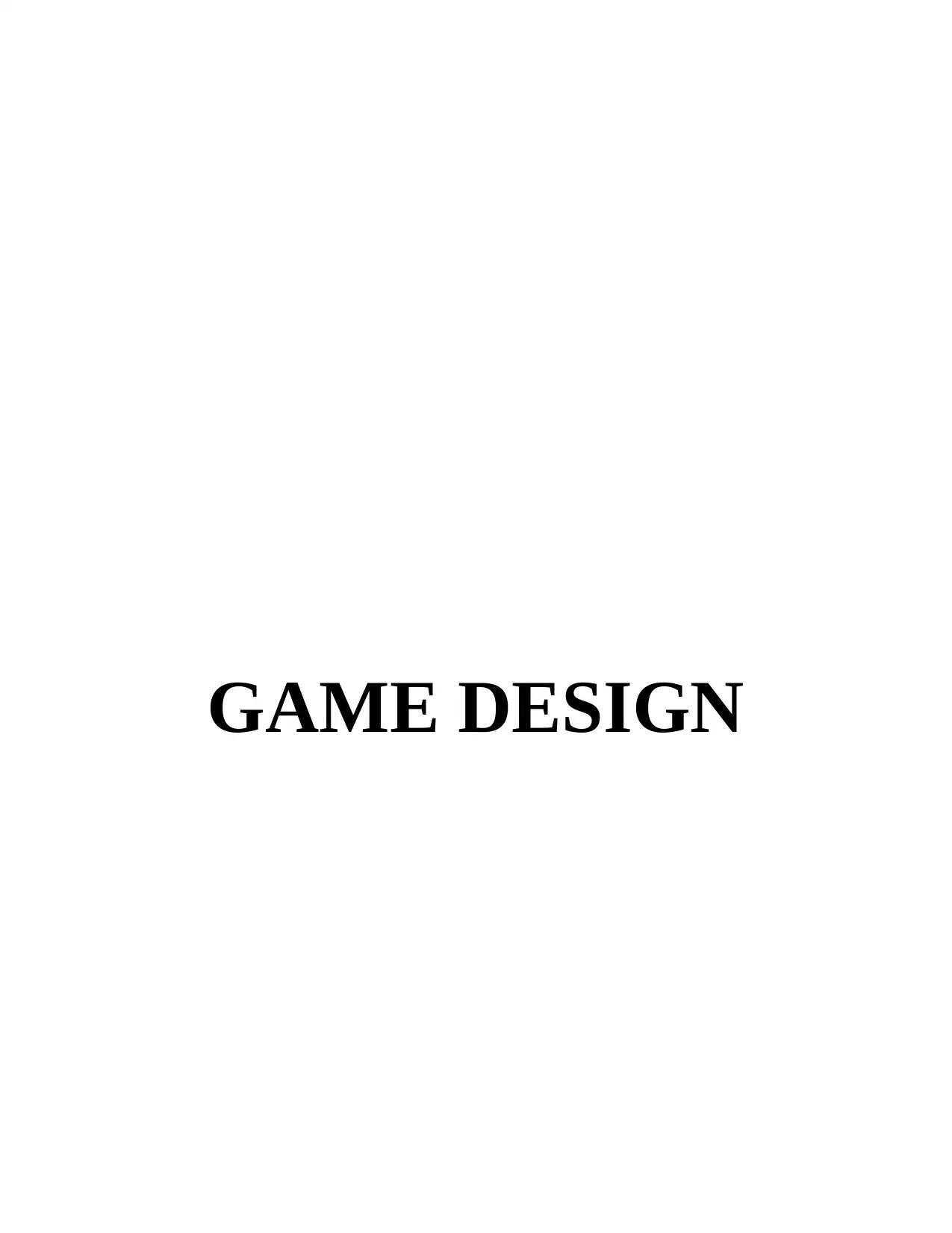
GAME DESIGN
Secure Best Marks with AI Grader
Need help grading? Try our AI Grader for instant feedback on your assignments.
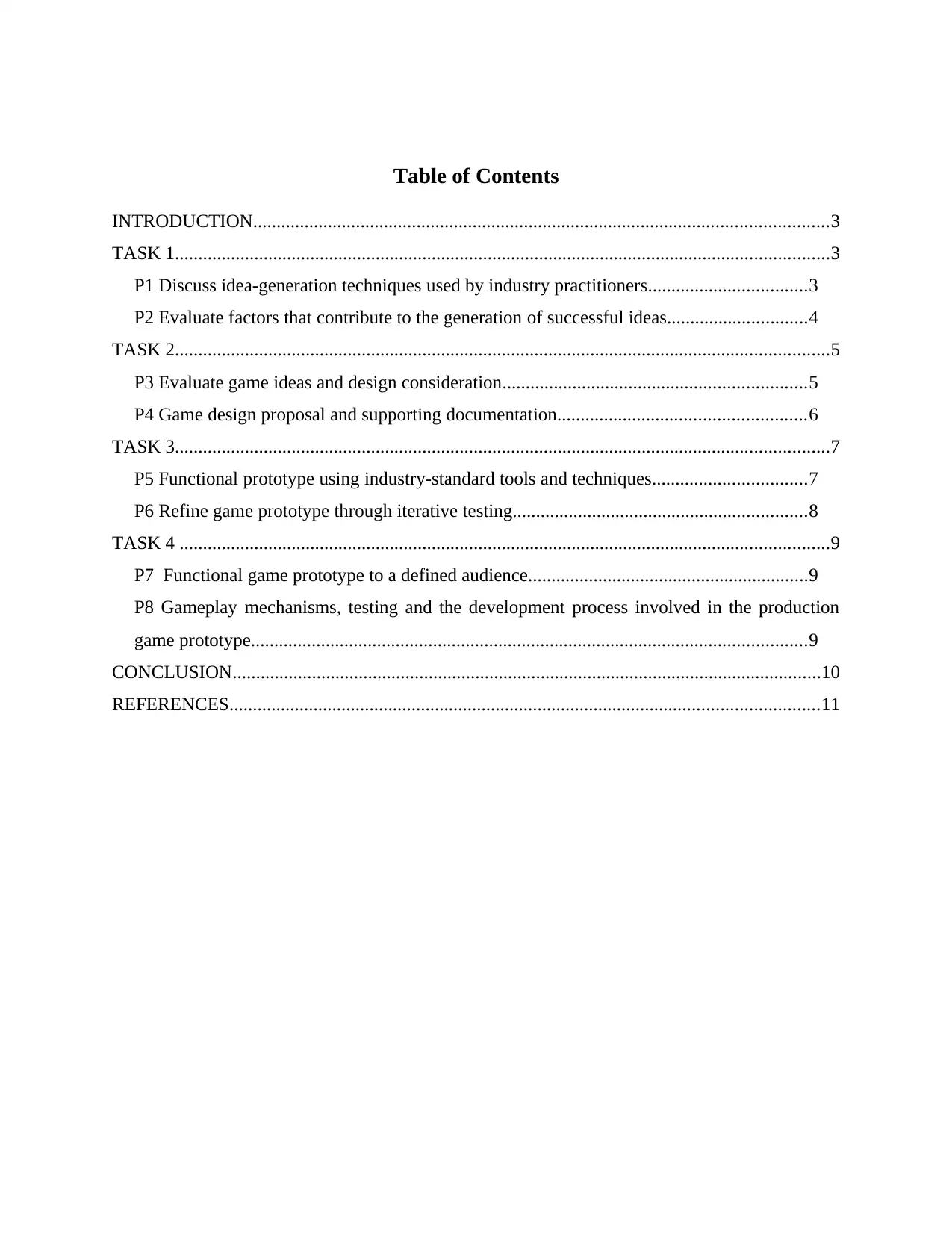
Table of Contents
INTRODUCTION...........................................................................................................................3
TASK 1............................................................................................................................................3
P1 Discuss idea-generation techniques used by industry practitioners..................................3
P2 Evaluate factors that contribute to the generation of successful ideas..............................4
TASK 2............................................................................................................................................5
P3 Evaluate game ideas and design consideration.................................................................5
P4 Game design proposal and supporting documentation.....................................................6
TASK 3............................................................................................................................................7
P5 Functional prototype using industry-standard tools and techniques.................................7
P6 Refine game prototype through iterative testing...............................................................8
TASK 4 ...........................................................................................................................................9
P7 Functional game prototype to a defined audience............................................................9
P8 Gameplay mechanisms, testing and the development process involved in the production
game prototype.......................................................................................................................9
CONCLUSION..............................................................................................................................10
REFERENCES..............................................................................................................................11
INTRODUCTION...........................................................................................................................3
TASK 1............................................................................................................................................3
P1 Discuss idea-generation techniques used by industry practitioners..................................3
P2 Evaluate factors that contribute to the generation of successful ideas..............................4
TASK 2............................................................................................................................................5
P3 Evaluate game ideas and design consideration.................................................................5
P4 Game design proposal and supporting documentation.....................................................6
TASK 3............................................................................................................................................7
P5 Functional prototype using industry-standard tools and techniques.................................7
P6 Refine game prototype through iterative testing...............................................................8
TASK 4 ...........................................................................................................................................9
P7 Functional game prototype to a defined audience............................................................9
P8 Gameplay mechanisms, testing and the development process involved in the production
game prototype.......................................................................................................................9
CONCLUSION..............................................................................................................................10
REFERENCES..............................................................................................................................11
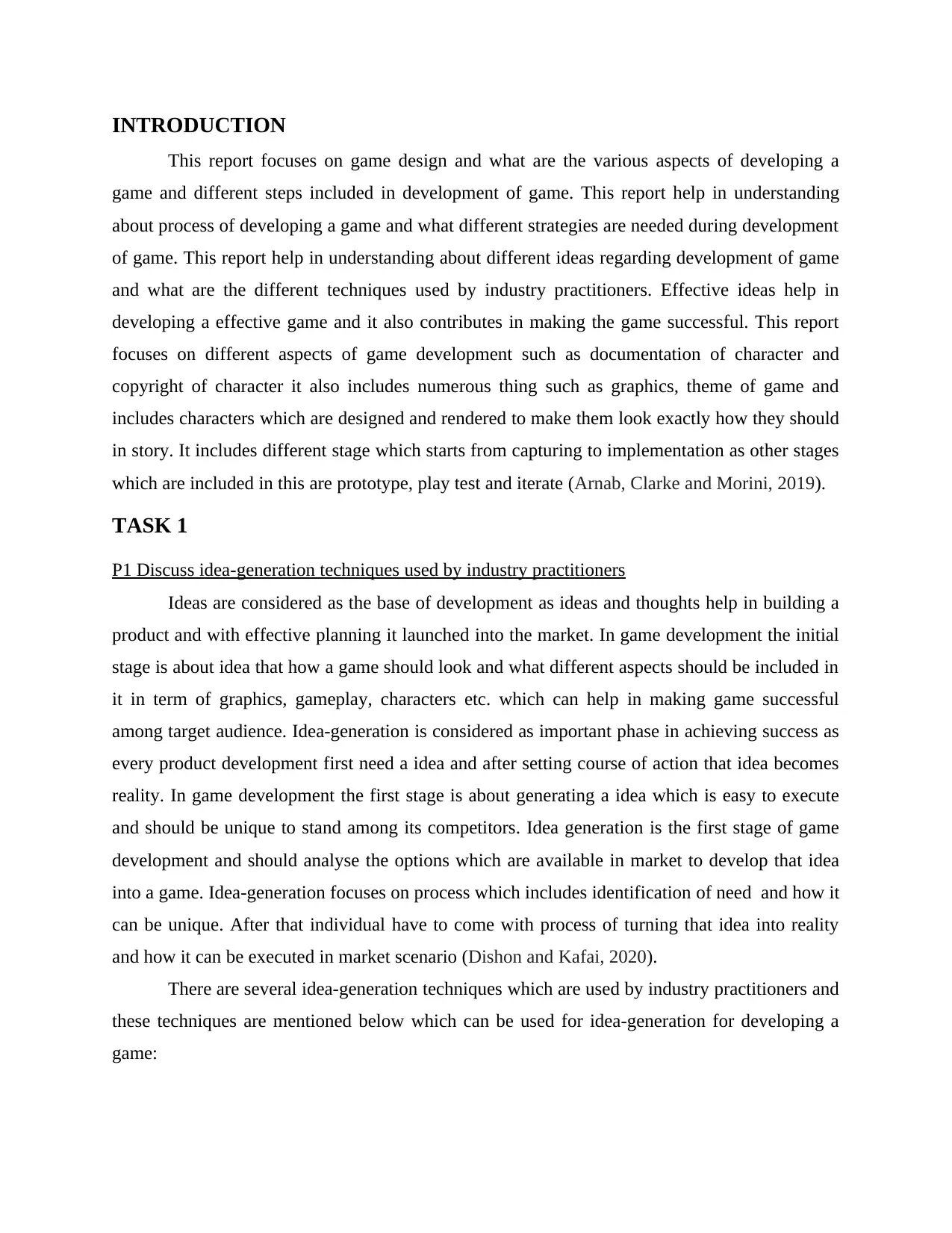
INTRODUCTION
This report focuses on game design and what are the various aspects of developing a
game and different steps included in development of game. This report help in understanding
about process of developing a game and what different strategies are needed during development
of game. This report help in understanding about different ideas regarding development of game
and what are the different techniques used by industry practitioners. Effective ideas help in
developing a effective game and it also contributes in making the game successful. This report
focuses on different aspects of game development such as documentation of character and
copyright of character it also includes numerous thing such as graphics, theme of game and
includes characters which are designed and rendered to make them look exactly how they should
in story. It includes different stage which starts from capturing to implementation as other stages
which are included in this are prototype, play test and iterate (Arnab, Clarke and Morini, 2019).
TASK 1
P1 Discuss idea-generation techniques used by industry practitioners
Ideas are considered as the base of development as ideas and thoughts help in building a
product and with effective planning it launched into the market. In game development the initial
stage is about idea that how a game should look and what different aspects should be included in
it in term of graphics, gameplay, characters etc. which can help in making game successful
among target audience. Idea-generation is considered as important phase in achieving success as
every product development first need a idea and after setting course of action that idea becomes
reality. In game development the first stage is about generating a idea which is easy to execute
and should be unique to stand among its competitors. Idea generation is the first stage of game
development and should analyse the options which are available in market to develop that idea
into a game. Idea-generation focuses on process which includes identification of need and how it
can be unique. After that individual have to come with process of turning that idea into reality
and how it can be executed in market scenario (Dishon and Kafai, 2020).
There are several idea-generation techniques which are used by industry practitioners and
these techniques are mentioned below which can be used for idea-generation for developing a
game:
This report focuses on game design and what are the various aspects of developing a
game and different steps included in development of game. This report help in understanding
about process of developing a game and what different strategies are needed during development
of game. This report help in understanding about different ideas regarding development of game
and what are the different techniques used by industry practitioners. Effective ideas help in
developing a effective game and it also contributes in making the game successful. This report
focuses on different aspects of game development such as documentation of character and
copyright of character it also includes numerous thing such as graphics, theme of game and
includes characters which are designed and rendered to make them look exactly how they should
in story. It includes different stage which starts from capturing to implementation as other stages
which are included in this are prototype, play test and iterate (Arnab, Clarke and Morini, 2019).
TASK 1
P1 Discuss idea-generation techniques used by industry practitioners
Ideas are considered as the base of development as ideas and thoughts help in building a
product and with effective planning it launched into the market. In game development the initial
stage is about idea that how a game should look and what different aspects should be included in
it in term of graphics, gameplay, characters etc. which can help in making game successful
among target audience. Idea-generation is considered as important phase in achieving success as
every product development first need a idea and after setting course of action that idea becomes
reality. In game development the first stage is about generating a idea which is easy to execute
and should be unique to stand among its competitors. Idea generation is the first stage of game
development and should analyse the options which are available in market to develop that idea
into a game. Idea-generation focuses on process which includes identification of need and how it
can be unique. After that individual have to come with process of turning that idea into reality
and how it can be executed in market scenario (Dishon and Kafai, 2020).
There are several idea-generation techniques which are used by industry practitioners and
these techniques are mentioned below which can be used for idea-generation for developing a
game:
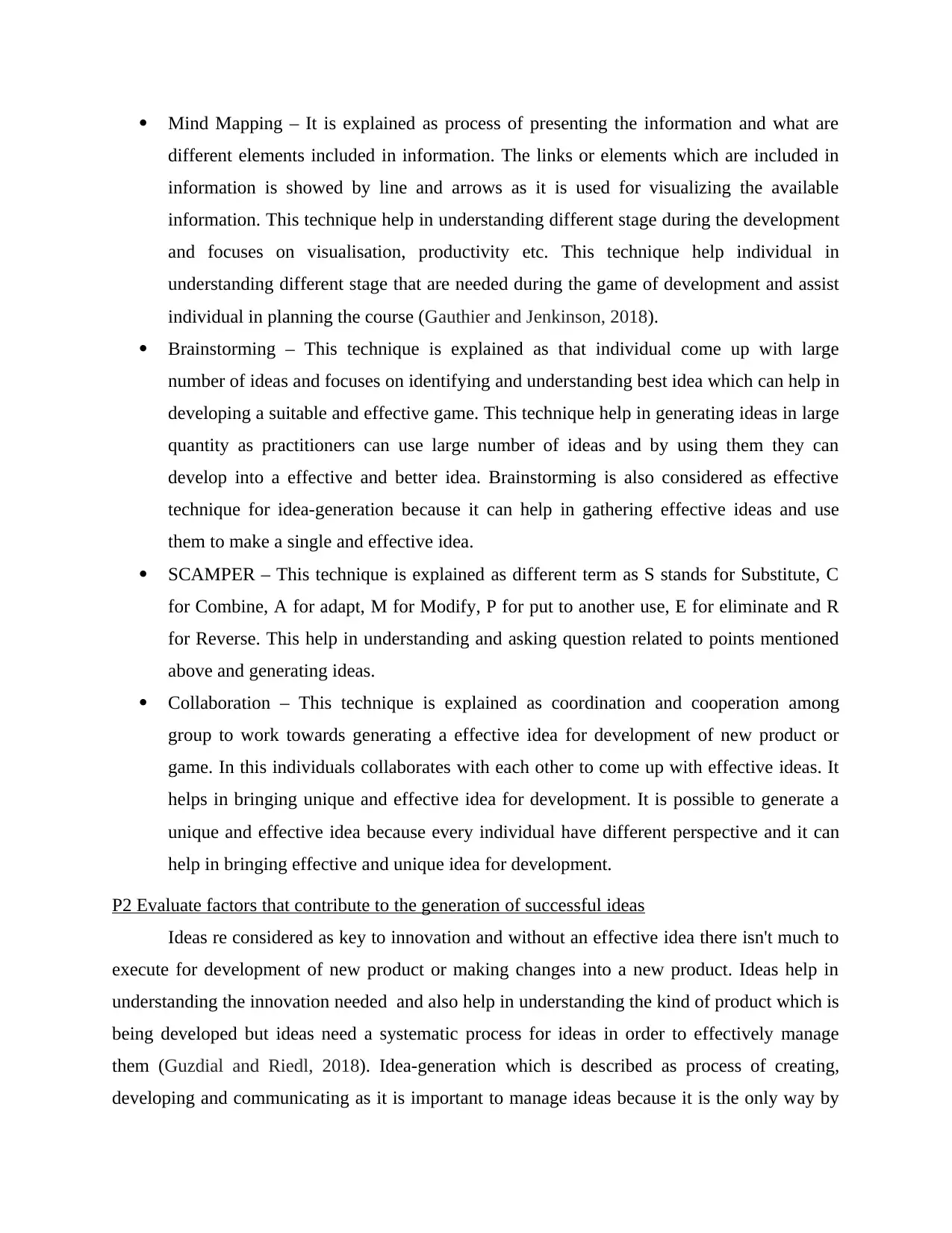
Mind Mapping – It is explained as process of presenting the information and what are
different elements included in information. The links or elements which are included in
information is showed by line and arrows as it is used for visualizing the available
information. This technique help in understanding different stage during the development
and focuses on visualisation, productivity etc. This technique help individual in
understanding different stage that are needed during the game of development and assist
individual in planning the course (Gauthier and Jenkinson, 2018).
Brainstorming – This technique is explained as that individual come up with large
number of ideas and focuses on identifying and understanding best idea which can help in
developing a suitable and effective game. This technique help in generating ideas in large
quantity as practitioners can use large number of ideas and by using them they can
develop into a effective and better idea. Brainstorming is also considered as effective
technique for idea-generation because it can help in gathering effective ideas and use
them to make a single and effective idea.
SCAMPER – This technique is explained as different term as S stands for Substitute, C
for Combine, A for adapt, M for Modify, P for put to another use, E for eliminate and R
for Reverse. This help in understanding and asking question related to points mentioned
above and generating ideas.
Collaboration – This technique is explained as coordination and cooperation among
group to work towards generating a effective idea for development of new product or
game. In this individuals collaborates with each other to come up with effective ideas. It
helps in bringing unique and effective idea for development. It is possible to generate a
unique and effective idea because every individual have different perspective and it can
help in bringing effective and unique idea for development.
P2 Evaluate factors that contribute to the generation of successful ideas
Ideas re considered as key to innovation and without an effective idea there isn't much to
execute for development of new product or making changes into a new product. Ideas help in
understanding the innovation needed and also help in understanding the kind of product which is
being developed but ideas need a systematic process for ideas in order to effectively manage
them (Guzdial and Riedl, 2018). Idea-generation which is described as process of creating,
developing and communicating as it is important to manage ideas because it is the only way by
different elements included in information. The links or elements which are included in
information is showed by line and arrows as it is used for visualizing the available
information. This technique help in understanding different stage during the development
and focuses on visualisation, productivity etc. This technique help individual in
understanding different stage that are needed during the game of development and assist
individual in planning the course (Gauthier and Jenkinson, 2018).
Brainstorming – This technique is explained as that individual come up with large
number of ideas and focuses on identifying and understanding best idea which can help in
developing a suitable and effective game. This technique help in generating ideas in large
quantity as practitioners can use large number of ideas and by using them they can
develop into a effective and better idea. Brainstorming is also considered as effective
technique for idea-generation because it can help in gathering effective ideas and use
them to make a single and effective idea.
SCAMPER – This technique is explained as different term as S stands for Substitute, C
for Combine, A for adapt, M for Modify, P for put to another use, E for eliminate and R
for Reverse. This help in understanding and asking question related to points mentioned
above and generating ideas.
Collaboration – This technique is explained as coordination and cooperation among
group to work towards generating a effective idea for development of new product or
game. In this individuals collaborates with each other to come up with effective ideas. It
helps in bringing unique and effective idea for development. It is possible to generate a
unique and effective idea because every individual have different perspective and it can
help in bringing effective and unique idea for development.
P2 Evaluate factors that contribute to the generation of successful ideas
Ideas re considered as key to innovation and without an effective idea there isn't much to
execute for development of new product or making changes into a new product. Ideas help in
understanding the innovation needed and also help in understanding the kind of product which is
being developed but ideas need a systematic process for ideas in order to effectively manage
them (Guzdial and Riedl, 2018). Idea-generation which is described as process of creating,
developing and communicating as it is important to manage ideas because it is the only way by
Secure Best Marks with AI Grader
Need help grading? Try our AI Grader for instant feedback on your assignments.
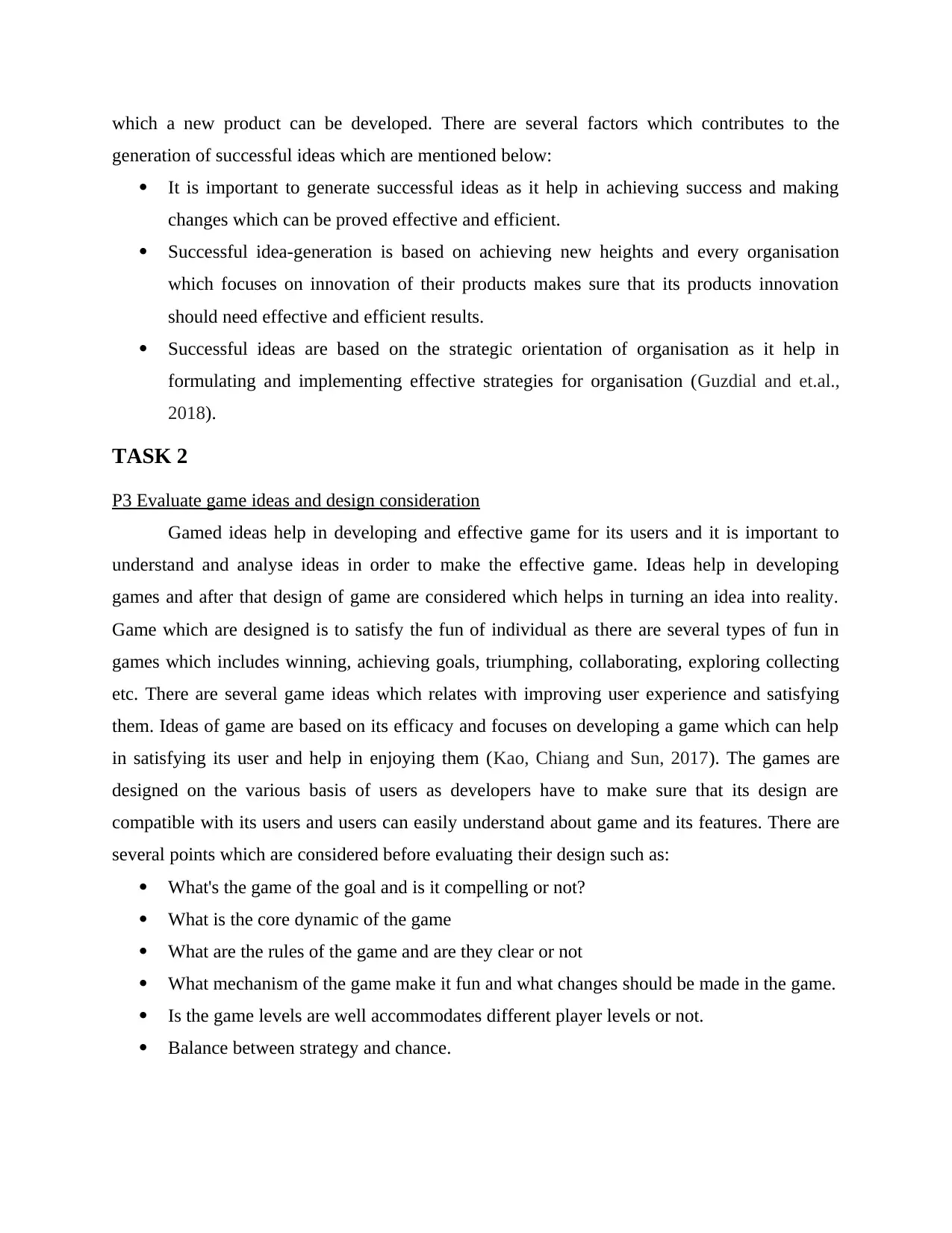
which a new product can be developed. There are several factors which contributes to the
generation of successful ideas which are mentioned below:
It is important to generate successful ideas as it help in achieving success and making
changes which can be proved effective and efficient.
Successful idea-generation is based on achieving new heights and every organisation
which focuses on innovation of their products makes sure that its products innovation
should need effective and efficient results.
Successful ideas are based on the strategic orientation of organisation as it help in
formulating and implementing effective strategies for organisation (Guzdial and et.al.,
2018).
TASK 2
P3 Evaluate game ideas and design consideration
Gamed ideas help in developing and effective game for its users and it is important to
understand and analyse ideas in order to make the effective game. Ideas help in developing
games and after that design of game are considered which helps in turning an idea into reality.
Game which are designed is to satisfy the fun of individual as there are several types of fun in
games which includes winning, achieving goals, triumphing, collaborating, exploring collecting
etc. There are several game ideas which relates with improving user experience and satisfying
them. Ideas of game are based on its efficacy and focuses on developing a game which can help
in satisfying its user and help in enjoying them (Kao, Chiang and Sun, 2017). The games are
designed on the various basis of users as developers have to make sure that its design are
compatible with its users and users can easily understand about game and its features. There are
several points which are considered before evaluating their design such as:
What's the game of the goal and is it compelling or not?
What is the core dynamic of the game
What are the rules of the game and are they clear or not
What mechanism of the game make it fun and what changes should be made in the game.
Is the game levels are well accommodates different player levels or not.
Balance between strategy and chance.
generation of successful ideas which are mentioned below:
It is important to generate successful ideas as it help in achieving success and making
changes which can be proved effective and efficient.
Successful idea-generation is based on achieving new heights and every organisation
which focuses on innovation of their products makes sure that its products innovation
should need effective and efficient results.
Successful ideas are based on the strategic orientation of organisation as it help in
formulating and implementing effective strategies for organisation (Guzdial and et.al.,
2018).
TASK 2
P3 Evaluate game ideas and design consideration
Gamed ideas help in developing and effective game for its users and it is important to
understand and analyse ideas in order to make the effective game. Ideas help in developing
games and after that design of game are considered which helps in turning an idea into reality.
Game which are designed is to satisfy the fun of individual as there are several types of fun in
games which includes winning, achieving goals, triumphing, collaborating, exploring collecting
etc. There are several game ideas which relates with improving user experience and satisfying
them. Ideas of game are based on its efficacy and focuses on developing a game which can help
in satisfying its user and help in enjoying them (Kao, Chiang and Sun, 2017). The games are
designed on the various basis of users as developers have to make sure that its design are
compatible with its users and users can easily understand about game and its features. There are
several points which are considered before evaluating their design such as:
What's the game of the goal and is it compelling or not?
What is the core dynamic of the game
What are the rules of the game and are they clear or not
What mechanism of the game make it fun and what changes should be made in the game.
Is the game levels are well accommodates different player levels or not.
Balance between strategy and chance.
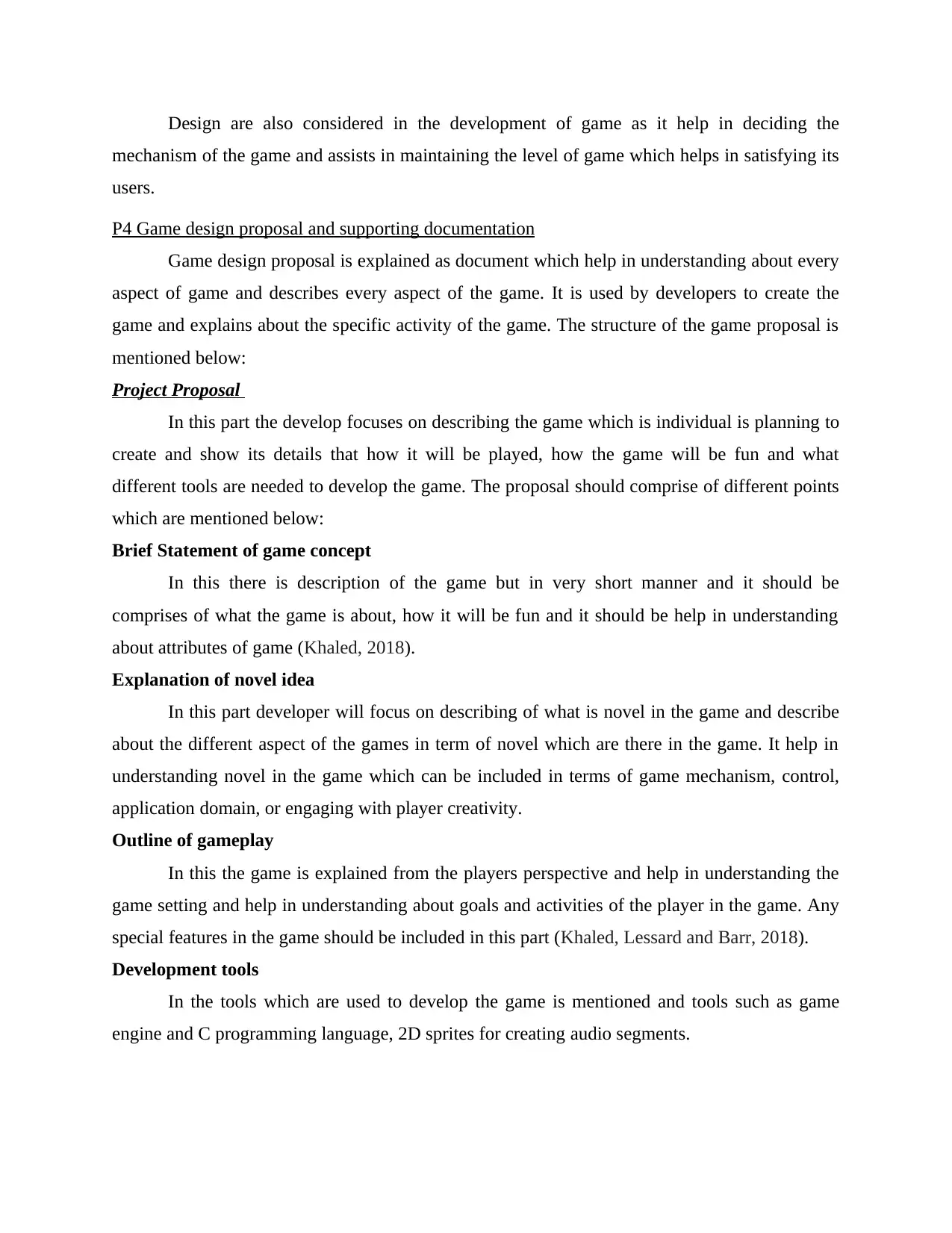
Design are also considered in the development of game as it help in deciding the
mechanism of the game and assists in maintaining the level of game which helps in satisfying its
users.
P4 Game design proposal and supporting documentation
Game design proposal is explained as document which help in understanding about every
aspect of game and describes every aspect of the game. It is used by developers to create the
game and explains about the specific activity of the game. The structure of the game proposal is
mentioned below:
Project Proposal
In this part the develop focuses on describing the game which is individual is planning to
create and show its details that how it will be played, how the game will be fun and what
different tools are needed to develop the game. The proposal should comprise of different points
which are mentioned below:
Brief Statement of game concept
In this there is description of the game but in very short manner and it should be
comprises of what the game is about, how it will be fun and it should be help in understanding
about attributes of game (Khaled, 2018).
Explanation of novel idea
In this part developer will focus on describing of what is novel in the game and describe
about the different aspect of the games in term of novel which are there in the game. It help in
understanding novel in the game which can be included in terms of game mechanism, control,
application domain, or engaging with player creativity.
Outline of gameplay
In this the game is explained from the players perspective and help in understanding the
game setting and help in understanding about goals and activities of the player in the game. Any
special features in the game should be included in this part (Khaled, Lessard and Barr, 2018).
Development tools
In the tools which are used to develop the game is mentioned and tools such as game
engine and C programming language, 2D sprites for creating audio segments.
mechanism of the game and assists in maintaining the level of game which helps in satisfying its
users.
P4 Game design proposal and supporting documentation
Game design proposal is explained as document which help in understanding about every
aspect of game and describes every aspect of the game. It is used by developers to create the
game and explains about the specific activity of the game. The structure of the game proposal is
mentioned below:
Project Proposal
In this part the develop focuses on describing the game which is individual is planning to
create and show its details that how it will be played, how the game will be fun and what
different tools are needed to develop the game. The proposal should comprise of different points
which are mentioned below:
Brief Statement of game concept
In this there is description of the game but in very short manner and it should be
comprises of what the game is about, how it will be fun and it should be help in understanding
about attributes of game (Khaled, 2018).
Explanation of novel idea
In this part developer will focus on describing of what is novel in the game and describe
about the different aspect of the games in term of novel which are there in the game. It help in
understanding novel in the game which can be included in terms of game mechanism, control,
application domain, or engaging with player creativity.
Outline of gameplay
In this the game is explained from the players perspective and help in understanding the
game setting and help in understanding about goals and activities of the player in the game. Any
special features in the game should be included in this part (Khaled, Lessard and Barr, 2018).
Development tools
In the tools which are used to develop the game is mentioned and tools such as game
engine and C programming language, 2D sprites for creating audio segments.
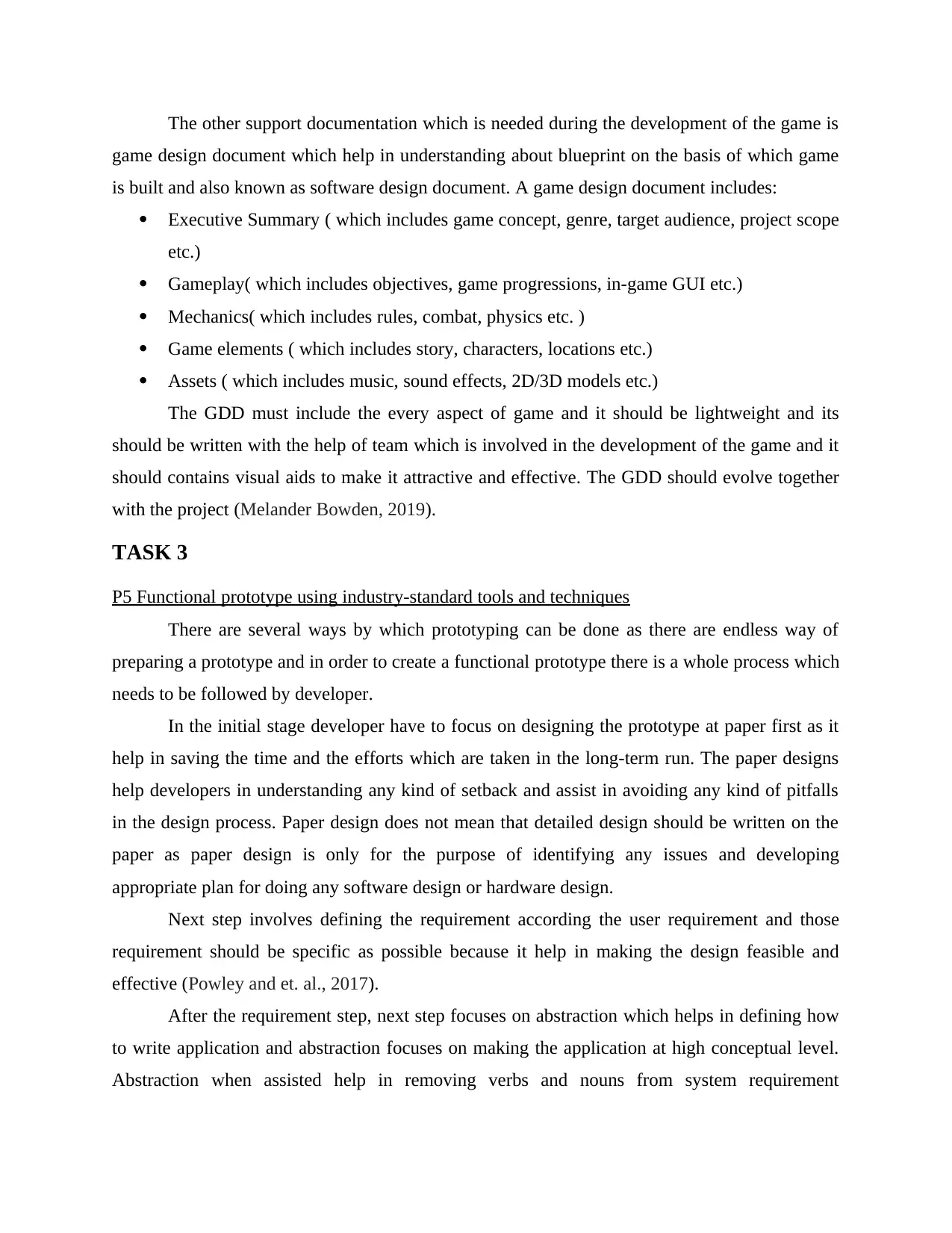
The other support documentation which is needed during the development of the game is
game design document which help in understanding about blueprint on the basis of which game
is built and also known as software design document. A game design document includes:
Executive Summary ( which includes game concept, genre, target audience, project scope
etc.)
Gameplay( which includes objectives, game progressions, in-game GUI etc.)
Mechanics( which includes rules, combat, physics etc. )
Game elements ( which includes story, characters, locations etc.)
Assets ( which includes music, sound effects, 2D/3D models etc.)
The GDD must include the every aspect of game and it should be lightweight and its
should be written with the help of team which is involved in the development of the game and it
should contains visual aids to make it attractive and effective. The GDD should evolve together
with the project (Melander Bowden, 2019).
TASK 3
P5 Functional prototype using industry-standard tools and techniques
There are several ways by which prototyping can be done as there are endless way of
preparing a prototype and in order to create a functional prototype there is a whole process which
needs to be followed by developer.
In the initial stage developer have to focus on designing the prototype at paper first as it
help in saving the time and the efforts which are taken in the long-term run. The paper designs
help developers in understanding any kind of setback and assist in avoiding any kind of pitfalls
in the design process. Paper design does not mean that detailed design should be written on the
paper as paper design is only for the purpose of identifying any issues and developing
appropriate plan for doing any software design or hardware design.
Next step involves defining the requirement according the user requirement and those
requirement should be specific as possible because it help in making the design feasible and
effective (Powley and et. al., 2017).
After the requirement step, next step focuses on abstraction which helps in defining how
to write application and abstraction focuses on making the application at high conceptual level.
Abstraction when assisted help in removing verbs and nouns from system requirement
game design document which help in understanding about blueprint on the basis of which game
is built and also known as software design document. A game design document includes:
Executive Summary ( which includes game concept, genre, target audience, project scope
etc.)
Gameplay( which includes objectives, game progressions, in-game GUI etc.)
Mechanics( which includes rules, combat, physics etc. )
Game elements ( which includes story, characters, locations etc.)
Assets ( which includes music, sound effects, 2D/3D models etc.)
The GDD must include the every aspect of game and it should be lightweight and its
should be written with the help of team which is involved in the development of the game and it
should contains visual aids to make it attractive and effective. The GDD should evolve together
with the project (Melander Bowden, 2019).
TASK 3
P5 Functional prototype using industry-standard tools and techniques
There are several ways by which prototyping can be done as there are endless way of
preparing a prototype and in order to create a functional prototype there is a whole process which
needs to be followed by developer.
In the initial stage developer have to focus on designing the prototype at paper first as it
help in saving the time and the efforts which are taken in the long-term run. The paper designs
help developers in understanding any kind of setback and assist in avoiding any kind of pitfalls
in the design process. Paper design does not mean that detailed design should be written on the
paper as paper design is only for the purpose of identifying any issues and developing
appropriate plan for doing any software design or hardware design.
Next step involves defining the requirement according the user requirement and those
requirement should be specific as possible because it help in making the design feasible and
effective (Powley and et. al., 2017).
After the requirement step, next step focuses on abstraction which helps in defining how
to write application and abstraction focuses on making the application at high conceptual level.
Abstraction when assisted help in removing verbs and nouns from system requirement
Paraphrase This Document
Need a fresh take? Get an instant paraphrase of this document with our AI Paraphraser
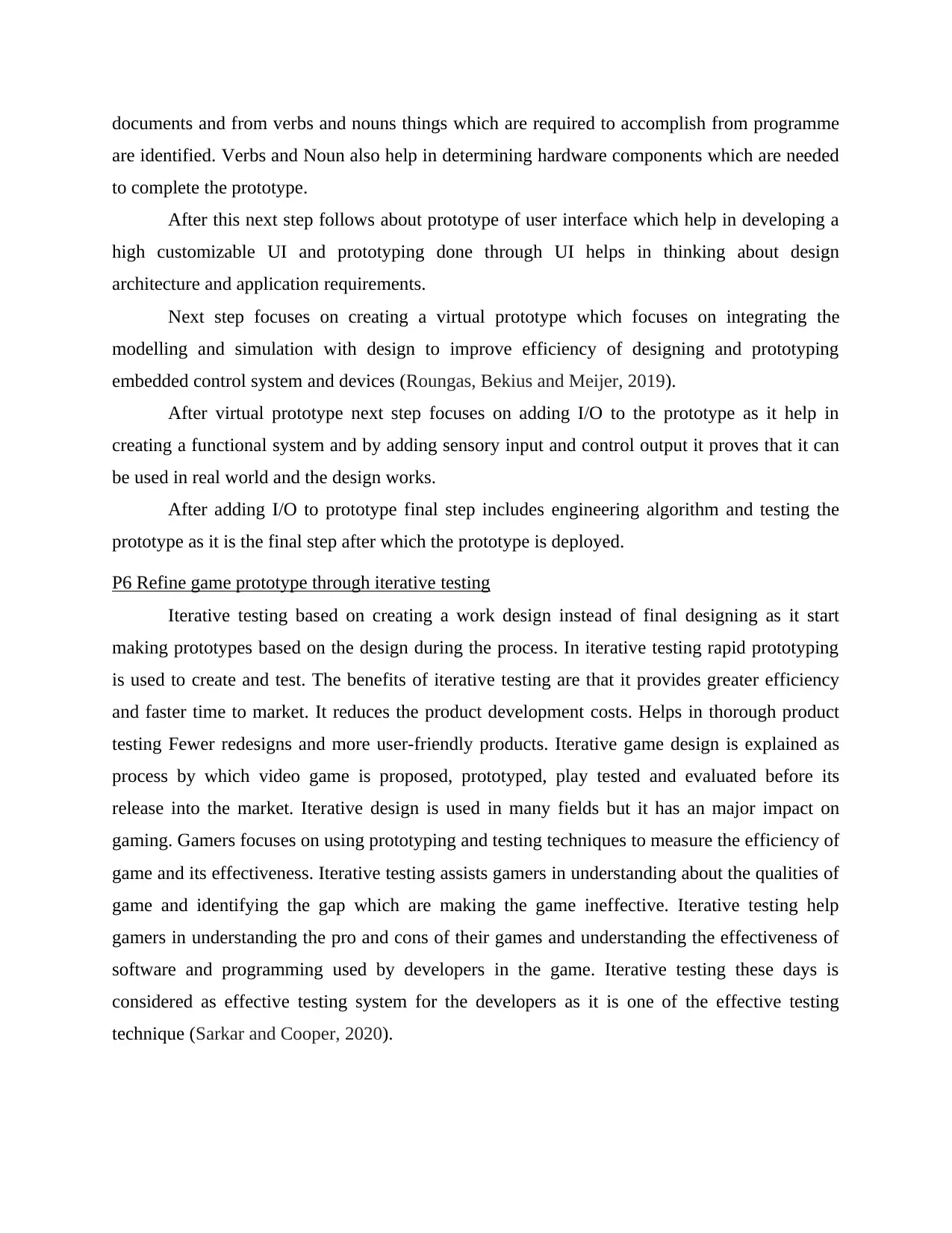
documents and from verbs and nouns things which are required to accomplish from programme
are identified. Verbs and Noun also help in determining hardware components which are needed
to complete the prototype.
After this next step follows about prototype of user interface which help in developing a
high customizable UI and prototyping done through UI helps in thinking about design
architecture and application requirements.
Next step focuses on creating a virtual prototype which focuses on integrating the
modelling and simulation with design to improve efficiency of designing and prototyping
embedded control system and devices (Roungas, Bekius and Meijer, 2019).
After virtual prototype next step focuses on adding I/O to the prototype as it help in
creating a functional system and by adding sensory input and control output it proves that it can
be used in real world and the design works.
After adding I/O to prototype final step includes engineering algorithm and testing the
prototype as it is the final step after which the prototype is deployed.
P6 Refine game prototype through iterative testing
Iterative testing based on creating a work design instead of final designing as it start
making prototypes based on the design during the process. In iterative testing rapid prototyping
is used to create and test. The benefits of iterative testing are that it provides greater efficiency
and faster time to market. It reduces the product development costs. Helps in thorough product
testing Fewer redesigns and more user-friendly products. Iterative game design is explained as
process by which video game is proposed, prototyped, play tested and evaluated before its
release into the market. Iterative design is used in many fields but it has an major impact on
gaming. Gamers focuses on using prototyping and testing techniques to measure the efficiency of
game and its effectiveness. Iterative testing assists gamers in understanding about the qualities of
game and identifying the gap which are making the game ineffective. Iterative testing help
gamers in understanding the pro and cons of their games and understanding the effectiveness of
software and programming used by developers in the game. Iterative testing these days is
considered as effective testing system for the developers as it is one of the effective testing
technique (Sarkar and Cooper, 2020).
are identified. Verbs and Noun also help in determining hardware components which are needed
to complete the prototype.
After this next step follows about prototype of user interface which help in developing a
high customizable UI and prototyping done through UI helps in thinking about design
architecture and application requirements.
Next step focuses on creating a virtual prototype which focuses on integrating the
modelling and simulation with design to improve efficiency of designing and prototyping
embedded control system and devices (Roungas, Bekius and Meijer, 2019).
After virtual prototype next step focuses on adding I/O to the prototype as it help in
creating a functional system and by adding sensory input and control output it proves that it can
be used in real world and the design works.
After adding I/O to prototype final step includes engineering algorithm and testing the
prototype as it is the final step after which the prototype is deployed.
P6 Refine game prototype through iterative testing
Iterative testing based on creating a work design instead of final designing as it start
making prototypes based on the design during the process. In iterative testing rapid prototyping
is used to create and test. The benefits of iterative testing are that it provides greater efficiency
and faster time to market. It reduces the product development costs. Helps in thorough product
testing Fewer redesigns and more user-friendly products. Iterative game design is explained as
process by which video game is proposed, prototyped, play tested and evaluated before its
release into the market. Iterative design is used in many fields but it has an major impact on
gaming. Gamers focuses on using prototyping and testing techniques to measure the efficiency of
game and its effectiveness. Iterative testing assists gamers in understanding about the qualities of
game and identifying the gap which are making the game ineffective. Iterative testing help
gamers in understanding the pro and cons of their games and understanding the effectiveness of
software and programming used by developers in the game. Iterative testing these days is
considered as effective testing system for the developers as it is one of the effective testing
technique (Sarkar and Cooper, 2020).
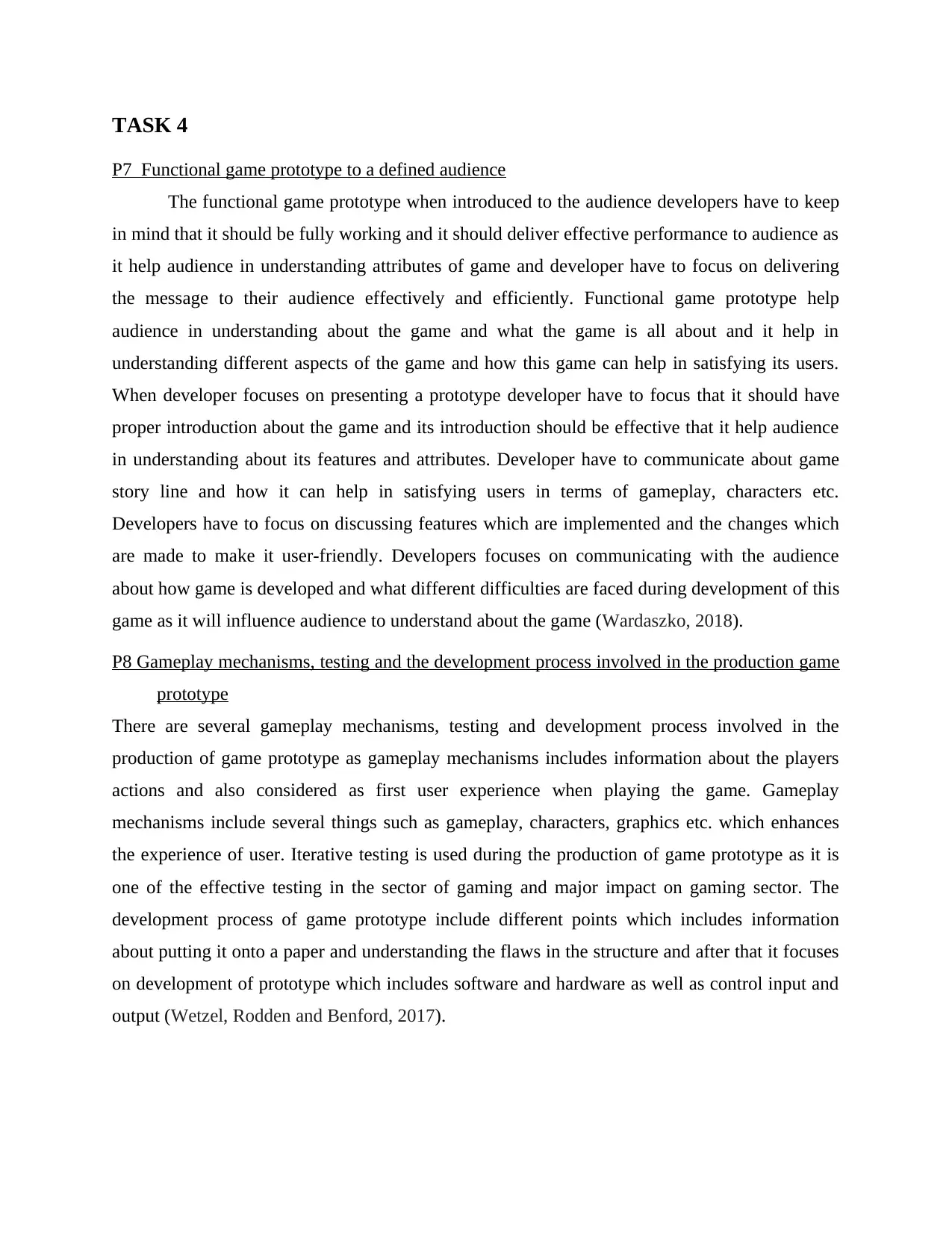
TASK 4
P7 Functional game prototype to a defined audience
The functional game prototype when introduced to the audience developers have to keep
in mind that it should be fully working and it should deliver effective performance to audience as
it help audience in understanding attributes of game and developer have to focus on delivering
the message to their audience effectively and efficiently. Functional game prototype help
audience in understanding about the game and what the game is all about and it help in
understanding different aspects of the game and how this game can help in satisfying its users.
When developer focuses on presenting a prototype developer have to focus that it should have
proper introduction about the game and its introduction should be effective that it help audience
in understanding about its features and attributes. Developer have to communicate about game
story line and how it can help in satisfying users in terms of gameplay, characters etc.
Developers have to focus on discussing features which are implemented and the changes which
are made to make it user-friendly. Developers focuses on communicating with the audience
about how game is developed and what different difficulties are faced during development of this
game as it will influence audience to understand about the game (Wardaszko, 2018).
P8 Gameplay mechanisms, testing and the development process involved in the production game
prototype
There are several gameplay mechanisms, testing and development process involved in the
production of game prototype as gameplay mechanisms includes information about the players
actions and also considered as first user experience when playing the game. Gameplay
mechanisms include several things such as gameplay, characters, graphics etc. which enhances
the experience of user. Iterative testing is used during the production of game prototype as it is
one of the effective testing in the sector of gaming and major impact on gaming sector. The
development process of game prototype include different points which includes information
about putting it onto a paper and understanding the flaws in the structure and after that it focuses
on development of prototype which includes software and hardware as well as control input and
output (Wetzel, Rodden and Benford, 2017).
P7 Functional game prototype to a defined audience
The functional game prototype when introduced to the audience developers have to keep
in mind that it should be fully working and it should deliver effective performance to audience as
it help audience in understanding attributes of game and developer have to focus on delivering
the message to their audience effectively and efficiently. Functional game prototype help
audience in understanding about the game and what the game is all about and it help in
understanding different aspects of the game and how this game can help in satisfying its users.
When developer focuses on presenting a prototype developer have to focus that it should have
proper introduction about the game and its introduction should be effective that it help audience
in understanding about its features and attributes. Developer have to communicate about game
story line and how it can help in satisfying users in terms of gameplay, characters etc.
Developers have to focus on discussing features which are implemented and the changes which
are made to make it user-friendly. Developers focuses on communicating with the audience
about how game is developed and what different difficulties are faced during development of this
game as it will influence audience to understand about the game (Wardaszko, 2018).
P8 Gameplay mechanisms, testing and the development process involved in the production game
prototype
There are several gameplay mechanisms, testing and development process involved in the
production of game prototype as gameplay mechanisms includes information about the players
actions and also considered as first user experience when playing the game. Gameplay
mechanisms include several things such as gameplay, characters, graphics etc. which enhances
the experience of user. Iterative testing is used during the production of game prototype as it is
one of the effective testing in the sector of gaming and major impact on gaming sector. The
development process of game prototype include different points which includes information
about putting it onto a paper and understanding the flaws in the structure and after that it focuses
on development of prototype which includes software and hardware as well as control input and
output (Wetzel, Rodden and Benford, 2017).
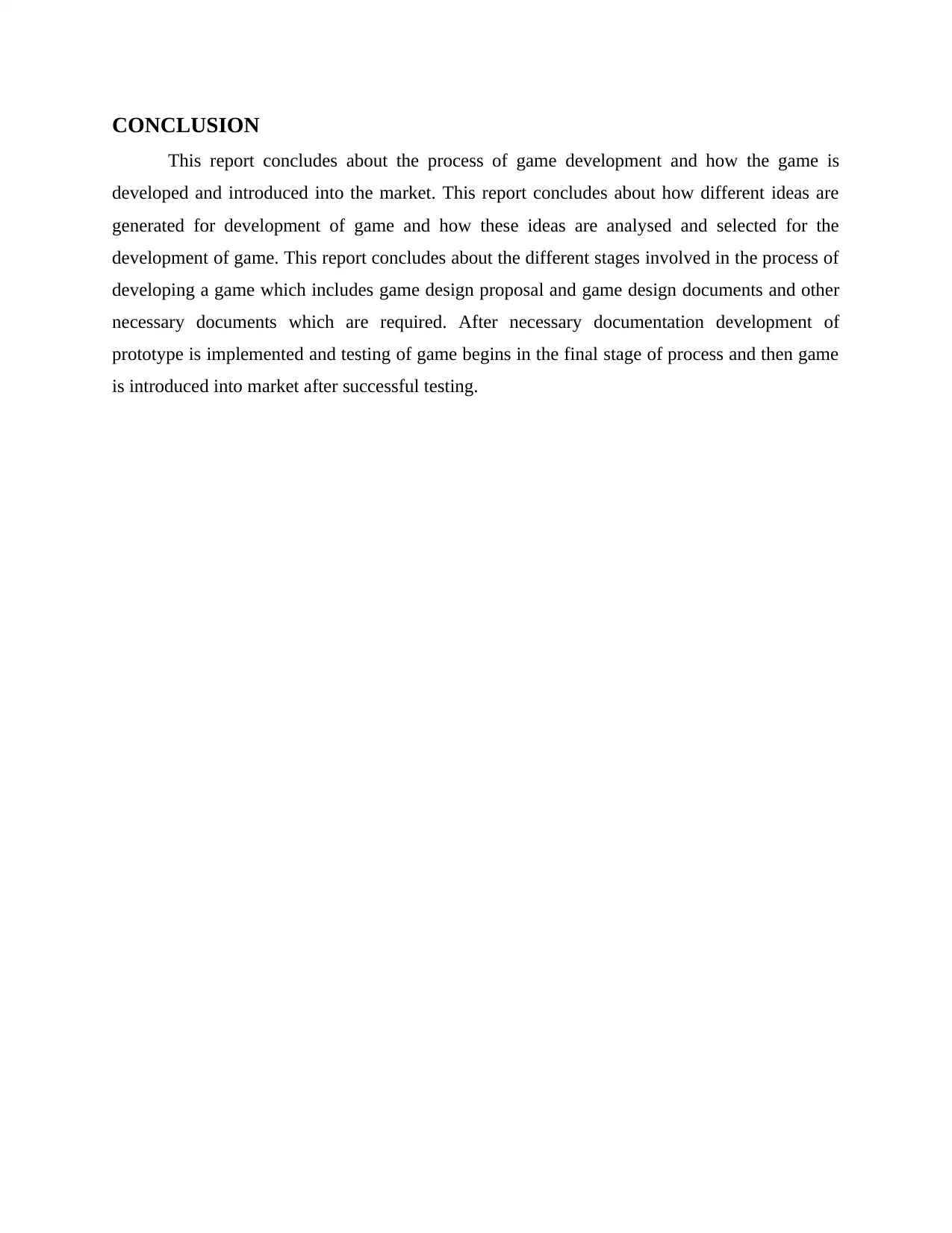
CONCLUSION
This report concludes about the process of game development and how the game is
developed and introduced into the market. This report concludes about how different ideas are
generated for development of game and how these ideas are analysed and selected for the
development of game. This report concludes about the different stages involved in the process of
developing a game which includes game design proposal and game design documents and other
necessary documents which are required. After necessary documentation development of
prototype is implemented and testing of game begins in the final stage of process and then game
is introduced into market after successful testing.
This report concludes about the process of game development and how the game is
developed and introduced into the market. This report concludes about how different ideas are
generated for development of game and how these ideas are analysed and selected for the
development of game. This report concludes about the different stages involved in the process of
developing a game which includes game design proposal and game design documents and other
necessary documents which are required. After necessary documentation development of
prototype is implemented and testing of game begins in the final stage of process and then game
is introduced into market after successful testing.
Secure Best Marks with AI Grader
Need help grading? Try our AI Grader for instant feedback on your assignments.
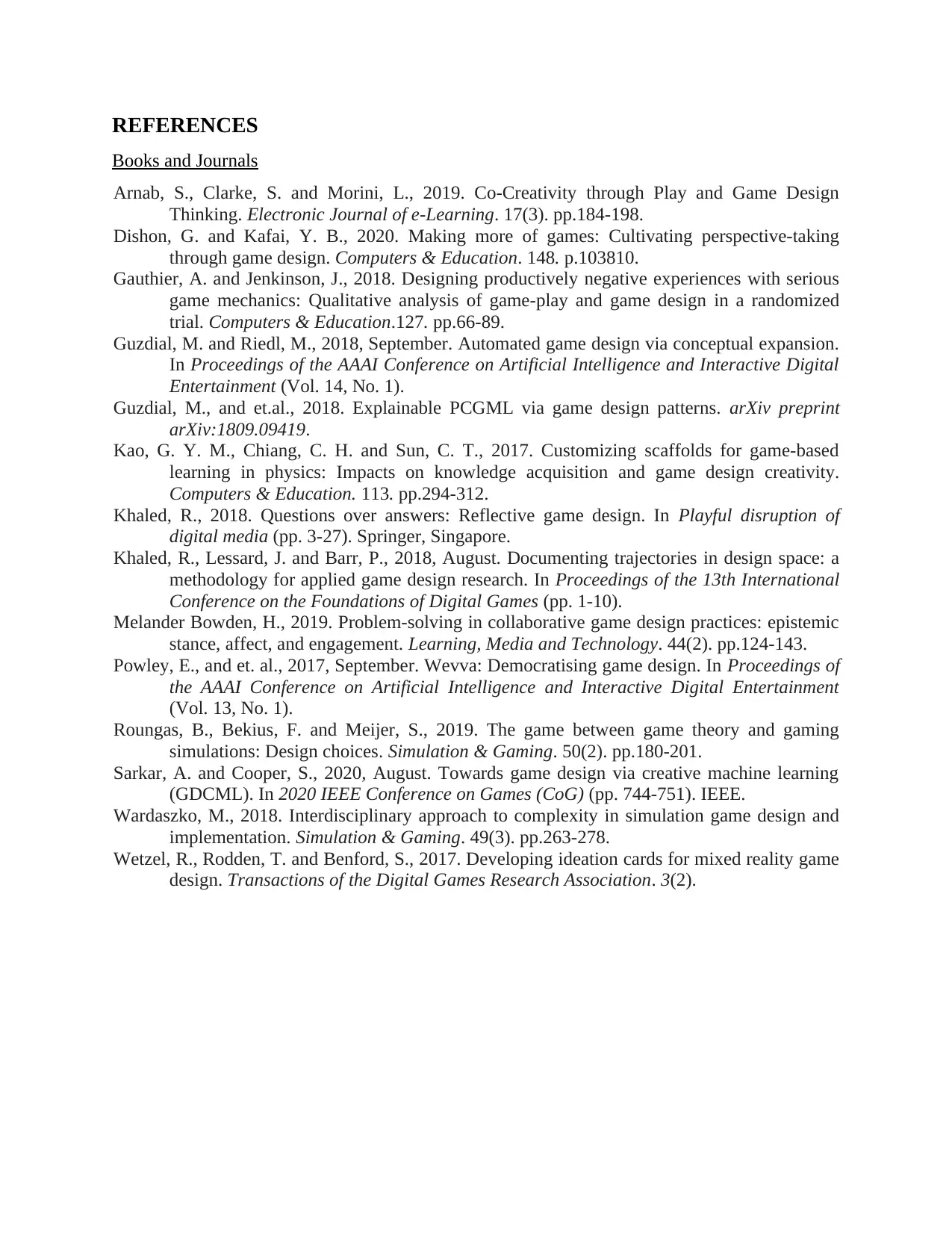
REFERENCES
Books and Journals
Arnab, S., Clarke, S. and Morini, L., 2019. Co-Creativity through Play and Game Design
Thinking. Electronic Journal of e-Learning. 17(3). pp.184-198.
Dishon, G. and Kafai, Y. B., 2020. Making more of games: Cultivating perspective-taking
through game design. Computers & Education. 148. p.103810.
Gauthier, A. and Jenkinson, J., 2018. Designing productively negative experiences with serious
game mechanics: Qualitative analysis of game-play and game design in a randomized
trial. Computers & Education.127. pp.66-89.
Guzdial, M. and Riedl, M., 2018, September. Automated game design via conceptual expansion.
In Proceedings of the AAAI Conference on Artificial Intelligence and Interactive Digital
Entertainment (Vol. 14, No. 1).
Guzdial, M., and et.al., 2018. Explainable PCGML via game design patterns. arXiv preprint
arXiv:1809.09419.
Kao, G. Y. M., Chiang, C. H. and Sun, C. T., 2017. Customizing scaffolds for game-based
learning in physics: Impacts on knowledge acquisition and game design creativity.
Computers & Education. 113. pp.294-312.
Khaled, R., 2018. Questions over answers: Reflective game design. In Playful disruption of
digital media (pp. 3-27). Springer, Singapore.
Khaled, R., Lessard, J. and Barr, P., 2018, August. Documenting trajectories in design space: a
methodology for applied game design research. In Proceedings of the 13th International
Conference on the Foundations of Digital Games (pp. 1-10).
Melander Bowden, H., 2019. Problem-solving in collaborative game design practices: epistemic
stance, affect, and engagement. Learning, Media and Technology. 44(2). pp.124-143.
Powley, E., and et. al., 2017, September. Wevva: Democratising game design. In Proceedings of
the AAAI Conference on Artificial Intelligence and Interactive Digital Entertainment
(Vol. 13, No. 1).
Roungas, B., Bekius, F. and Meijer, S., 2019. The game between game theory and gaming
simulations: Design choices. Simulation & Gaming. 50(2). pp.180-201.
Sarkar, A. and Cooper, S., 2020, August. Towards game design via creative machine learning
(GDCML). In 2020 IEEE Conference on Games (CoG) (pp. 744-751). IEEE.
Wardaszko, M., 2018. Interdisciplinary approach to complexity in simulation game design and
implementation. Simulation & Gaming. 49(3). pp.263-278.
Wetzel, R., Rodden, T. and Benford, S., 2017. Developing ideation cards for mixed reality game
design. Transactions of the Digital Games Research Association. 3(2).
Books and Journals
Arnab, S., Clarke, S. and Morini, L., 2019. Co-Creativity through Play and Game Design
Thinking. Electronic Journal of e-Learning. 17(3). pp.184-198.
Dishon, G. and Kafai, Y. B., 2020. Making more of games: Cultivating perspective-taking
through game design. Computers & Education. 148. p.103810.
Gauthier, A. and Jenkinson, J., 2018. Designing productively negative experiences with serious
game mechanics: Qualitative analysis of game-play and game design in a randomized
trial. Computers & Education.127. pp.66-89.
Guzdial, M. and Riedl, M., 2018, September. Automated game design via conceptual expansion.
In Proceedings of the AAAI Conference on Artificial Intelligence and Interactive Digital
Entertainment (Vol. 14, No. 1).
Guzdial, M., and et.al., 2018. Explainable PCGML via game design patterns. arXiv preprint
arXiv:1809.09419.
Kao, G. Y. M., Chiang, C. H. and Sun, C. T., 2017. Customizing scaffolds for game-based
learning in physics: Impacts on knowledge acquisition and game design creativity.
Computers & Education. 113. pp.294-312.
Khaled, R., 2018. Questions over answers: Reflective game design. In Playful disruption of
digital media (pp. 3-27). Springer, Singapore.
Khaled, R., Lessard, J. and Barr, P., 2018, August. Documenting trajectories in design space: a
methodology for applied game design research. In Proceedings of the 13th International
Conference on the Foundations of Digital Games (pp. 1-10).
Melander Bowden, H., 2019. Problem-solving in collaborative game design practices: epistemic
stance, affect, and engagement. Learning, Media and Technology. 44(2). pp.124-143.
Powley, E., and et. al., 2017, September. Wevva: Democratising game design. In Proceedings of
the AAAI Conference on Artificial Intelligence and Interactive Digital Entertainment
(Vol. 13, No. 1).
Roungas, B., Bekius, F. and Meijer, S., 2019. The game between game theory and gaming
simulations: Design choices. Simulation & Gaming. 50(2). pp.180-201.
Sarkar, A. and Cooper, S., 2020, August. Towards game design via creative machine learning
(GDCML). In 2020 IEEE Conference on Games (CoG) (pp. 744-751). IEEE.
Wardaszko, M., 2018. Interdisciplinary approach to complexity in simulation game design and
implementation. Simulation & Gaming. 49(3). pp.263-278.
Wetzel, R., Rodden, T. and Benford, S., 2017. Developing ideation cards for mixed reality game
design. Transactions of the Digital Games Research Association. 3(2).
1 out of 11
Related Documents
Your All-in-One AI-Powered Toolkit for Academic Success.
+13062052269
info@desklib.com
Available 24*7 on WhatsApp / Email
![[object Object]](/_next/static/media/star-bottom.7253800d.svg)
Unlock your academic potential
© 2024 | Zucol Services PVT LTD | All rights reserved.





